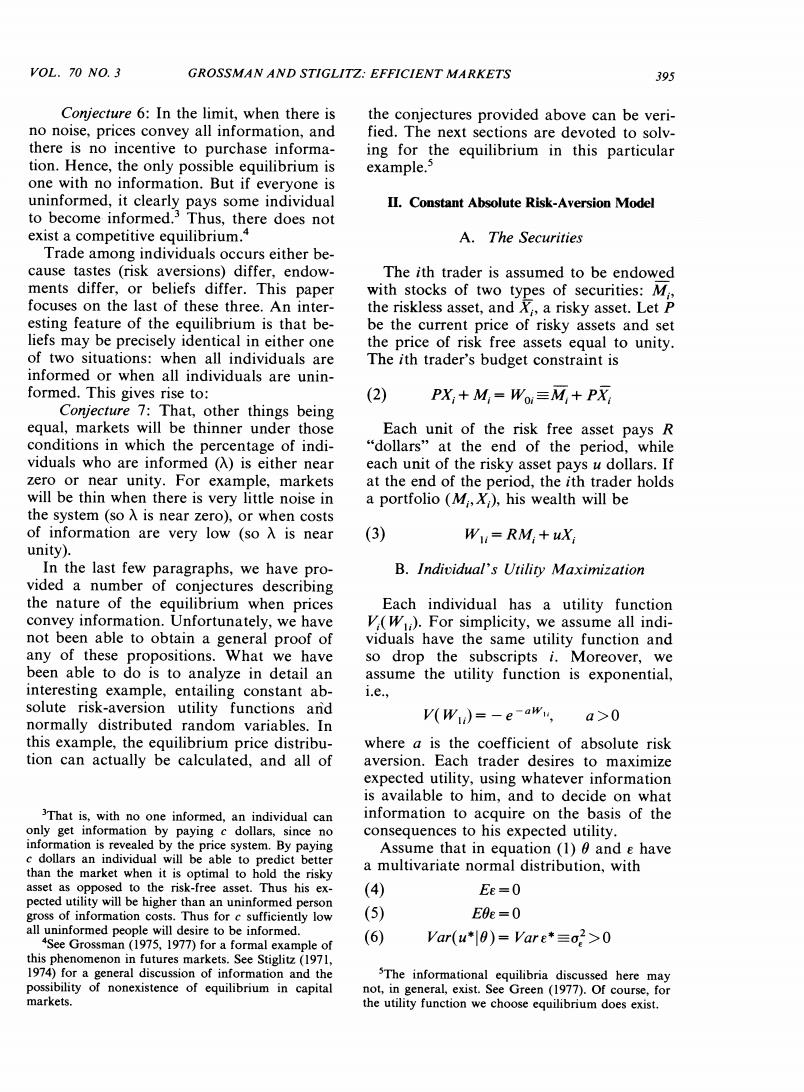正在加载图片...

VOL.70 NO.3 GROSSMAN AND STIGLITZ:EFFICIENT MARKETS 395 Conjecture 6:In the limit,when there is the conjectures provided above can be veri- no noise,prices convey all information,and fied.The next sections are devoted to solv- there is no incentive to purchase informa- ing for the equilibrium in this particular tion.Hence,the only possible equilibrium is example.> one with no information.But if everyone is uninformed,it clearly pays some individual II.Constant Absolute Risk-Aversion Model to become informed.3 Thus,there does not exist a competitive equilibrium. A.The Securities Trade among individuals occurs either be- cause tastes (risk aversions)differ,endow- The ith trader is assumed to be endowed ments differ,or beliefs differ.This paper with stocks of two types of securities:Mi focuses on the last of these three.An inter- the riskless asset,and Xi,a risky asset.Let P esting feature of the equilibrium is that be- be the current price of risky assets and set liefs may be precisely identical in either one the price of risk free assets equal to unity. of two situations:when all individuals are The ith trader's budget constraint is informed or when all individuals are unin- formed.This gives rise to: (2) PX,+M,=Wo≡M,+PX Conjecture 7:That,other things being equal,markets will be thinner under those Each unit of the risk free asset pays R conditions in which the percentage of indi- “dollars'”at the end of the period,while viduals who are informed (A)is either near each unit of the risky asset pays u dollars.If zero or near unity.For example,markets at the end of the period,the ith trader holds will be thin when there is very little noise in a portfolio (M,X )his wealth will be the system(so A is near zero),or when costs of information are very low (so A is near (3) W=RM +ux unity). In the last few paragraphs,we have pro- B.Individual's Utility Maximization vided a number of conjectures describing the nature of the equilibrium when prices Each individual has a utility function convey information.Unfortunately,we have V(W).For simplicity,we assume all indi- not been able to obtain a general proof of viduals have the same utility function and any of these propositions.What we have so drop the subscripts i.Moreover,we been able to do is to analyze in detail an assume the utility function is exponential, interesting example,entailing constant ab- i.e., solute risk-aversion utility functions and normally distributed random variables.In V(Wu)=-e-ow, a>0 this example,the equilibrium price distribu- where a is the coefficient of absolute risk tion can actually be calculated,and all of aversion.Each trader desires to maximize expected utility,using whatever information is available to him,and to decide on what 3That is,with no one informed,an individual can information to acquire on the basis of the only get information by paying c dollars,since no consequences to his expected utility. information is revealed by the price system.By paying Assume that in equation (1)0 and e have c dollars an individual will be able to predict better than the market when it is optimal to hold the risky a multivariate normal distribution,with asset as opposed to the risk-free asset.Thus his ex- (4) Ee=0 pected utility will be higher than an uninformed person gross of information costs.Thus for c sufficiently low (5) E0e=0 all uninformed people will desire to be informed. 4See Grossman (1975,1977)for a formal example of (6) Var(u*0)=Vare*=02>0 this phenomenon in futures markets.See Stiglitz(1971, 1974)for a general discussion of information and the SThe informational equilibria discussed here may possibility of nonexistence of equilibrium in capital not,in general,exist.See Green (1977).Of course,for markets. the utility function we choose equilibrium does exist